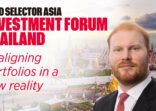Do you think we will see a bounce back in the performance of the 60/40 portfolio this year?

2022 was a difficult year for the 60/40 portfolio but it is unlikely to repeat itself in the near term.
Compared to 2022, our multi-asset team meaningfully increased the expected returns for select equity and fixed income assets given attractive valuations and expectations that we might be heading towards the end of the hiking cycle. This typically bodes well for 60/40 portfolios, in our view.
Having said that, investors would have to diversify their portfolios more so than in the past given higher rates may stay longer.
Investors need more thoughtful risk management and a “modernised” approach to the 60/40 portfolio, which means they can diversify their portfolio by adding more sub-asset classes.
Within equities, our “modernised” 60/40 portfolio tilts towards high alpha diversifiers such as Emerging Market equities and small or mid-cap stocks.
Chinese equities have exhibited low correlation with global equities historically for various reasons such as underrepresentation in global portfolios and high domestic retail ownership of stocks. Given China is on a different monetary cycle, we think that adding exposures to Chinese equities can be one of the options for investors to diversify their portfolios.
What impact will a potential softening US dollar have on Asia?

Historically, we found a strong inverse relationship of USD and Asia equities as Asia tended to outperform developed markets in a weak USD environment.
This could be explained by the fact that a weaker USD makes Asian assets more attractive from capital allocation perspectives for international investors.
Apart from drawing capital into the region, a weaker USD can also reduce pressure on Asian central banks to raise rates to defend their currency. Without aggressive rate hikes, it is easier to maintain financial stability.
Lastly, imported inflation will likely be lower too if Asian currencies are stronger so that also reduces the pressure for Asian central banks to raise rates.
What is the best way to position portfolios in relation to China’s reopening?

Reopening can be broadly divided into three stages.
In stage one, we witnessed the rerating of direct reopening plays. These include online travel agencies, restaurant chains, airlines, Macau gaming, etc. Investors need to be more selective here as the market has set high expectations on these sectors to deliver their earnings.
In stage two, we expect to see the economy recover more broadly and more downstream consumer businesses will likely benefit. These include shopping malls, apparel, sportswear, etc. As people get more comfortable with their spending, spill over effects to big ticket items such as home appliances and furniture may follow.
In stage three, business confidence is expected to come back as confidence has come back. More entrepreneurs may open new businesses, which could drive the demand for upstream equipment, hardware, etc. Companies may also be more willing to invest so their budget for advertising may go up, which in turn will likely benefit advertisement companies. In addition, more workers may be needed so demand for recruitment services may increase as well.

















